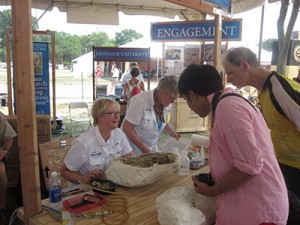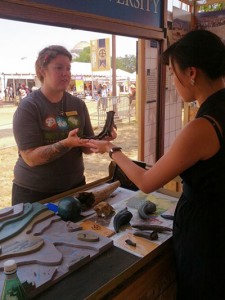Smithsonian Folklife Festival 2012: Dinosaur Dig
Special thanks to Smithsonian Affiliations intern, Neema Amadala (University of Calgary, Alberta, Canada), for this guest post.
In contrast to the University of Illinois’ cool, canopied hard-court, Lisa and I stumbled back in time to a dinosaur dig. It was a 100 degree day (or 38°C for those of us metrically inclined) and perhaps an inopportune time to be outside digging for dinosaurs. In my opinion, the best part of being a Smithsonian Affiliations intern is meeting the Affiliates: seeing the dedication they have to their projects is wonderful. For this reason, I hoped to meet a celebrity of sorts, Dr. Alan Grant of Jurassic Park fame. Not the fictional character but Dr. Jack Horner on whom Sam Neill’s character in the trilogy was the partial inspiration for and paleontological advisor to. To my chagrin, Dr. Horner had left the 2012 Smithsonian Folklife Festival but there were still dinosaurs to discover.

Visitors watching intently at the preparation of a specimen. Photo courtesy Smithsonian Affiliations.
On this particular dig, we were under the cover of the Museum of the Rockies (MOR), a Smithsonian Affiliate in Bozeman, Montana. I watched as children and adults wandered in, fascinated as always, by these prehistoric creatures who we discover anew every day. Festival goers could choose to conduct their own dinosaur dig, learn how casting a fossil works, watch a member of the Field Crew prepare a specimen for the lab or just learn more about Montana’s prehistoric past. Everyone on the dig was engaged and the wealth of experience and excitement MOR brought to the Folklife Festival was visible on the faces of all who passed through on the dig.
Lisa Lundgren, with MOR’s educational team, helped visitors learn about the history not just beneath the soil of Montana’s badlands but visible in its multicolored sedimentary strands. Explaining MOR’s own connection and contribution to fossil history Lisa and I were introduced to Maiasaura or ‘good mother lizard’: a giant dinosaur that unlike its contemporaries raised and fed their hatchlings. There were plenty of tactile and visual aids to keep us engaged and connected to the subject matter and like the children around me, I relished my time with the dinos.

Smithsonian Affiliations intern Lisa Hung with Lisa Lundgren from Affiliate, Museum of the Rockies. Photo courtesy Smithsonian Affiliations.
This time travelling experience showcased the expertise and knowledge that Affiliates can bring to the Smithsonian. Being an Affiliate can be about more than the loaning of artifacts, there can be an exchange of programs and expertise along with interaction with the community at large. Not only did the Festival provide exposure to visitors about Montana’s primordial past, perhaps embedding MOR as a potential stop on a future trip, but also enriched the learning experience that the Smithsonian seeks to provide to all.





